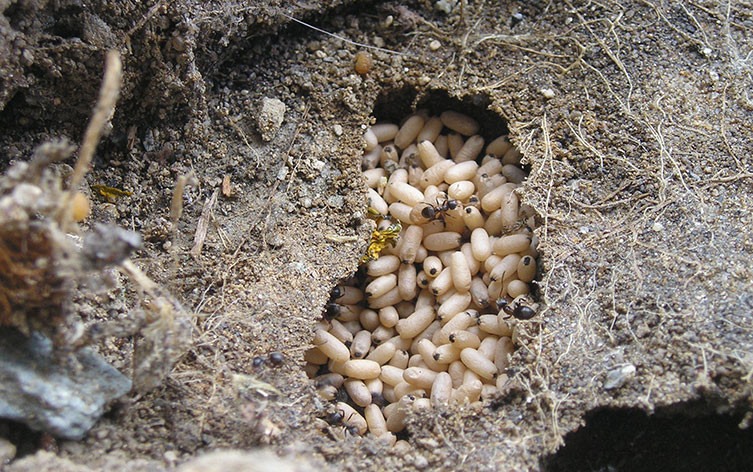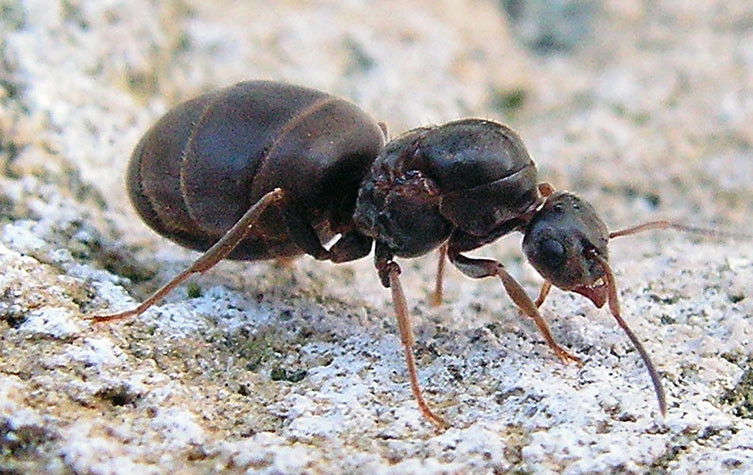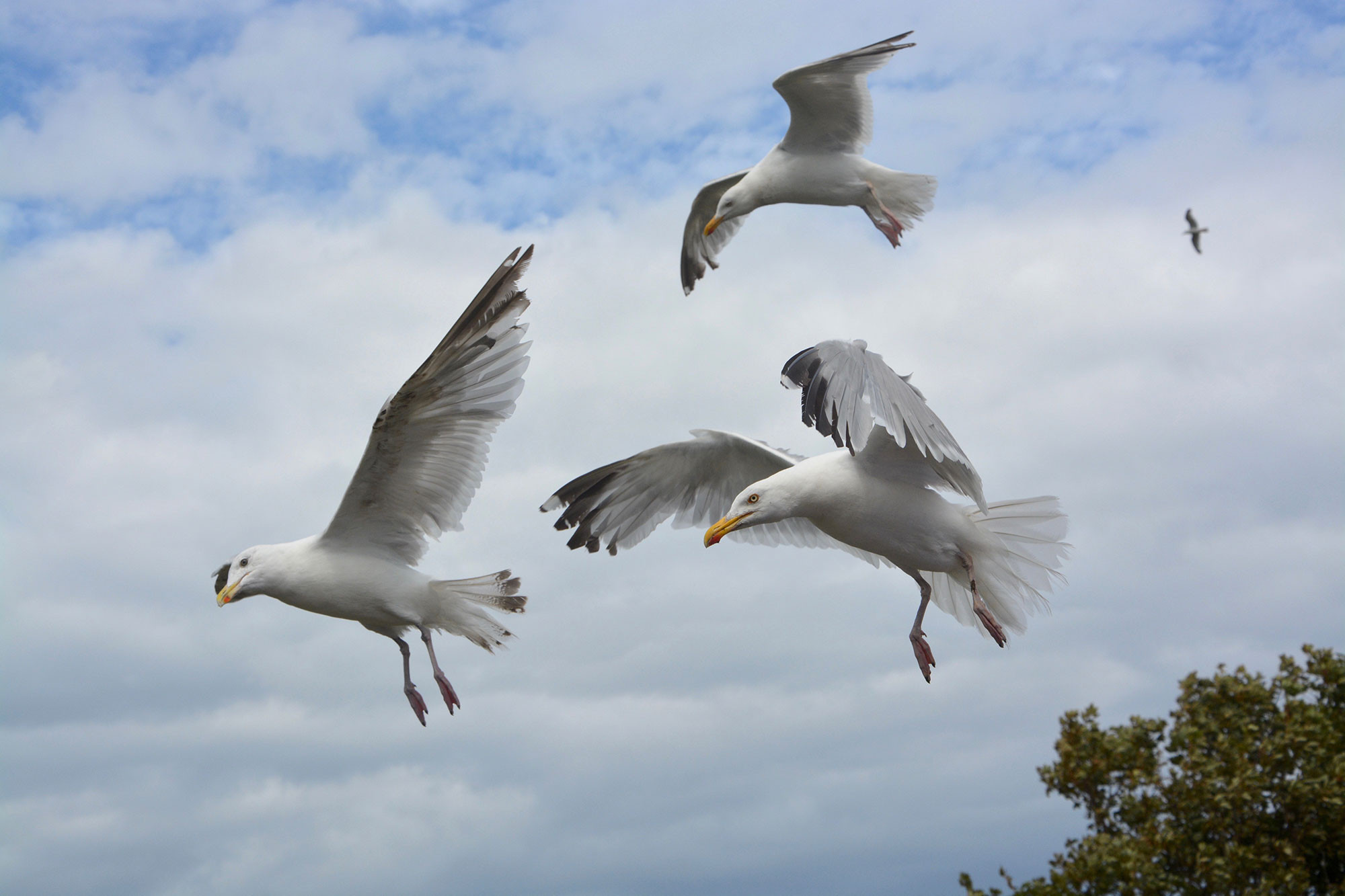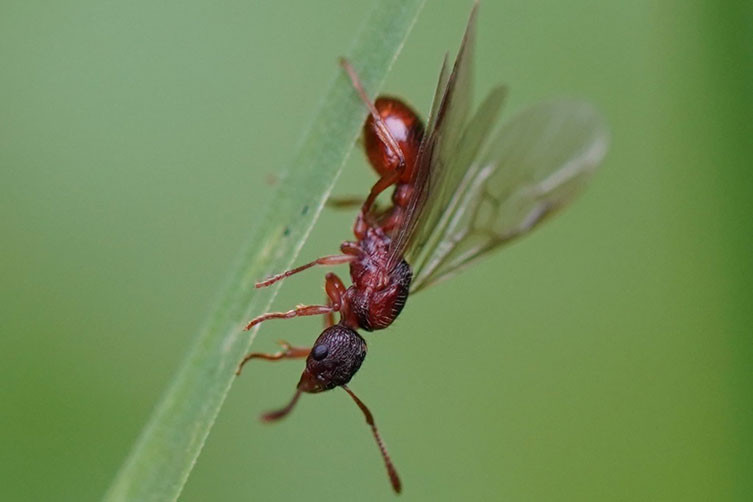Can Ants Turn Into Flies? No, ants cannot turn into flies, but some ants do have wings and are often mistaken for flies; discover more about the fascinating world of flying ants at flyermedia.net. These flying ants are actually sexually mature queens and males embarking on their nuptial flight to mate and establish new colonies, not evolving into a different insect altogether. Dive deeper into entomology, ant life cycles, and the science behind their swarming behavior with us.
1. What are Flying Ants, and Why Do They Have Wings?
Flying ants are scientifically known as alates. These winged ants are the sexually mature queens and males of ant species, primarily seen during their nuptial flight, the time they seek out a mate.
What Exactly Are Alates?
Alates are not a separate species of ant but rather a stage in the life cycle of certain ants. They are produced when a colony reaches a certain size and maturity. According to research from the Royal Entomological Society, these alates have one purpose: reproduction.
Why Do Only Some Ants Have Wings?
Only queens and males have wings because their primary role is to mate and establish new colonies. Worker ants, which are sterile females, do not have wings, as their job is to maintain and defend the existing colony. This division of labor ensures the survival and propagation of the ant species.
(licensed under CC BY 2.0](https://www.nhm.ac.uk/content/dam/nhm-www/discover/flying-ant-day/winged-ants-on-building-two-column.jpg)
2. When Does “Flying Ant Day” Occur?
“Flying Ant Day” isn’t a single day, but rather a season usually occurring in July or August, characterized by hot and humid weather, perfect for the nuptial flight of these insects.
What Triggers the Swarming of Flying Ants?
Swarming is triggered by specific weather conditions, primarily warm, wind-free days after a period of improved weather. According to a multi-year citizen science project by the Royal Society of Biology, there’s no single ‘flying ant day.’ Instead, there’s a ‘flying ant season’ where winged ants emerge over several weeks with multiple peak appearances, each lasting a few days.
Are Flying Ants More Common in Urban or Rural Areas?
Flying ants are often observed earlier in urban areas compared to rural areas. This is largely due to the urban heat island effect, where urban environments tend to be warmer than their rural counterparts.
(licensed under CC BY 2.0](https://www.nhm.ac.uk/content/dam/nhm-www/discover/flying-ant-day/winged-ants-pavement-two-column.jpg)
3. Where Do Flying Ants Come From, and What is Their Purpose?
Flying ants come from established ant colonies and emerge to participate in the nuptial flight, where they mate and the queens establish new colonies.
How Do Ant Colonies Produce Flying Ants?
Ants live in a caste system where the queen lays eggs, and female workers care for the queen, eggs, and larvae. When the colony is ready, the queen produces virgin queens and males. These winged males (drones) and virgin queens (princesses) emerge to mate and form new colonies, ensuring genetic diversity by scattering and mating with ants from different colonies.
What is the Nuptial Flight?
The nuptial flight is a critical event where winged males and virgin queens leave their nests to mate. The large winged females and smaller winged males are often seen flying together. During this brief, once-in-a-lifetime mating period, a queen usually mates with several males, ensuring a diverse genetic pool for her future colony.
 Exposed ant nest
Exposed ant nest
4. What Happens After the Nuptial Flight?
After mating, the males die, and the queens shed their wings to find a suitable nesting site and start a new colony, ensuring the continuation of the ant species.
How Do Queen Ants Start New Colonies?
Once mated, the queen chews off her wings and seeks a suitable site to nest and establish a new colony. She digs an underground chamber and lays her first eggs, which she rears to adulthood without eating until her first brood of daughter workers can forage for her. The sperm she received during the nuptial flight enables her to lay fertilized eggs for the rest of her life, often reproducing until her colony numbers thousands.
What is the Role of Worker Ants?
The ants you see the rest of the year are female workers. They gather food for the colony, maintain the nest, and care for the queen and her offspring.
 A queen ant that no longer has wings
A queen ant that no longer has wings
5. How Long Do Flying Ants Live?
The lifespan of flying ants varies significantly between males and queens, with males living only a few days after mating and queens living up to 15 years.
What is the Lifespan of Male Flying Ants?
Male flying ants typically live only a day or two after the nuptial flight. Their sole purpose is to mate with new queens, after which they die.
How Long Do Queen Ants Live?
Queen ants can live up to 15 years, sometimes even longer in captivity. According to the University of Florida Entomology Department, Lasius niger queens in captivity have reached 28 years. They spend most of their lives in their nest, laying eggs and ensuring the growth and survival of the colony.
6. Are Flying Ants Harmful, and Why Are They Considered a Good Thing?
Flying ants are generally harmless to humans and play a vital role in improving soil quality and serving as a food source for various animals, contributing to ecosystem health.
How Do Flying Ants Benefit the Environment?
Flying ants contribute to the ecosystem in several ways. Their tunneling activities improve soil quality, aerating the soil and facilitating nutrient distribution. Additionally, they serve as a crucial food resource for many bird species.
What Animals Benefit from Flying Ants?
Many species of birds, such as swifts and gulls, feed on flying ants during their swarming events. These insects provide a vital source of protein and nutrients for these animals.
 Three flying seagulls
Three flying seagulls
7. What is the Relationship Between Ants and Butterflies?
Ants, particularly the black garden ant and cornfield ant, have a mutually beneficial relationship with the silver-studded blue butterfly, where ants protect butterfly caterpillars from predators in exchange for secretions.
How Do Ants Help Butterflies?
The ants tend to the caterpillars of the silver-studded blue butterfly, protecting them from predators. In return, the ants feed on secretions produced by the caterpillars, creating a mutually beneficial relationship. This relationship is crucial for the survival of the butterfly, as its populations have declined across much of its range.
Why is This Relationship Important?
This symbiotic relationship is particularly important for the conservation of the silver-studded blue butterfly. The ants’ protection helps the caterpillars survive, contributing to the butterfly’s population stability.
 A few ants on a Plebejus argus caterpillar
A few ants on a Plebejus argus caterpillar
8. What Types of Ants Fly in the UK?
In the UK, various ant species grow wings and swarm, including black garden ants (Lasius niger) and red ants (Myrmica rubra), each with different timings for their nuptial flights based on weather conditions.
Which Ant Species Are Most Commonly Seen Flying?
The most commonly observed flying ants are the black garden ants (Lasius niger), also known as the common black ant. According to flying ant surveys conducted by the Royal Society of Biology, nearly 90% of the winged ants observed were of this species.
Do Red Ants Fly?
Yes, red ants (Myrmica rubra) are among the other common ant species in Britain that grow wings and swarm. The types of ants you see flying will depend on the specific location and environmental conditions.
 Winged Myrmica rubra ant
Winged Myrmica rubra ant
9. How Can I Identify Flying Ants?
Flying ants can be identified by their three distinct body parts and wings, which are characteristics of the Hymenoptera insect group that includes ants, bees, and wasps.
What Physical Traits Define Flying Ants?
Flying ants have three distinct body parts: a head, thorax, and abdomen. They also have wings, which distinguish them from worker ants. These wings are used for the nuptial flight, during which they mate and establish new colonies.
How Do Flying Ants Differ from Other Flying Insects?
Flying ants differ from other flying insects due to their ant-like body structure and behavior. Unlike flies, which have only two wings, flying ants have four. Their swarming behavior and association with ant colonies are also unique characteristics.
10. Why Do Flying Ants Swarm in Large Numbers?
Flying ants swarm in large numbers for protection from predators and to increase their chances of finding a mate, maximizing the success of reproduction.
What Protection Do Large Swarms Offer?
Swarming provides protection from predators. The sheer number of flying ants overwhelms predators, increasing the chances of survival for individual ants.
How Does Swarming Increase the Chance of Reproduction?
Swarming increases the chance of reproduction by bringing large numbers of potential mates together in a small area. This maximizes the likelihood of successful mating encounters.
11. Debunking Myths: Do Ants Really Turn into Flies?
No, ants do not turn into flies; flying ants are simply a specific stage in the ant life cycle where sexually mature queens and males have wings for mating and dispersal.
The Truth About Ant Metamorphosis
Ants undergo a complete metamorphosis, which includes egg, larva, pupa, and adult stages. At no point does an ant transform into a different species, such as a fly. The winged ants are simply a reproductive phase within certain ant species.
Why the Confusion?
The confusion arises because people often see winged ants and mistakenly believe they are turning into a different insect. The appearance of wings on these ants is solely for the purpose of reproduction and dispersal.
12. What Role Do Environmental Factors Play in Flying Ant Season?
Environmental factors such as temperature, humidity, and wind play crucial roles in triggering and influencing the swarming behavior of flying ants.
How Does Temperature Affect Flying Ant Swarms?
Warm temperatures are essential for flying ant swarms. Ants tend to fly on days when it is warm, as this provides the energy and conditions necessary for flight and mating.
How Does Humidity Influence Flying Ant Activity?
High humidity levels also contribute to the swarming behavior of flying ants. Humid conditions help prevent the ants from drying out during their nuptial flight, ensuring they can successfully mate and establish new colonies.
Why is Wind a Factor?
Ants avoid flying on windy days because wind makes it difficult for them to control their flight and navigate. Calm, wind-free days are ideal for swarming, as they allow the ants to fly efficiently and find mates.
13. Exploring Different Species of Flying Ants Around the World
While black garden ants are common in the UK, other species of flying ants exist worldwide, each adapted to their local environments and playing specific ecological roles.
Flying Ants in North America
In North America, various species of flying ants can be found, including those in the genus Camponotus (carpenter ants) and Formica. These ants play important roles in soil aeration and nutrient cycling.
Flying Ants in Tropical Regions
Tropical regions are home to a diverse range of flying ant species. These ants often have unique behaviors and adaptations, such as specialized nesting habits and symbiotic relationships with other organisms.
The Ecological Significance of Diverse Species
Each species of flying ant plays a specific role in its ecosystem, contributing to biodiversity and maintaining ecological balance. Understanding these roles is crucial for conservation efforts and ecosystem management.
14. How to Manage Flying Ants in Your Garden
While flying ants are beneficial to the environment, their presence in large numbers can be a nuisance in gardens. Here are some tips on how to manage them:
Natural Deterrents
Using natural deterrents such as peppermint oil, vinegar, or cinnamon can help keep flying ants away from your garden without harming the environment.
Maintaining a Clean Garden
Keeping your garden clean and free of food debris can reduce the attraction for ants. Regularly clean up spills and remove any decaying organic matter.
Professional Pest Control
If the infestation is severe, consider consulting a professional pest control service. They can provide effective and environmentally friendly solutions to manage flying ant populations.
15. The Future of Flying Ant Research
Ongoing research into flying ants continues to reveal new insights into their behavior, ecology, and evolutionary adaptations, contributing to our understanding of insect biology and ecosystem dynamics.
Citizen Science Projects
Citizen science projects play a crucial role in gathering data on flying ant populations and behavior. These projects engage the public in scientific research and provide valuable information for scientists.
Advances in Entomological Studies
Advances in entomological studies are providing new insights into the genetics, physiology, and behavior of flying ants. This knowledge can be used to develop more effective and sustainable management strategies.
Conservation Efforts
Conservation efforts are focused on protecting the habitats and ecosystems that support flying ant populations and the species that depend on them. These efforts are essential for maintaining biodiversity and ecological balance.
Ready to dive deeper into the world of aviation and entomology? Visit flyermedia.net for more information on ant life cycles, aviation news, flight school insights, and thrilling career opportunities. Whether you’re fascinated by the science of insects or dream of soaring through the skies, flyermedia.net is your go-to resource. Contact us at +1 (386) 226-6000 or visit our Daytona Beach location at 600 S Clyde Morris Blvd, FL 32114, United States. Let your curiosity take flight with flyermedia.net today!
FAQ: Flying Ants
1. Are flying ants dangerous?
Flying ants are not dangerous to humans. They do not bite or sting and are primarily focused on mating and establishing new colonies.
2. Why are there so many flying ants at once?
Flying ants swarm in large numbers for protection from predators and to increase their chances of finding a mate.
3. How long does flying ant season last?
Flying ant season typically lasts for several weeks in July and August, with peak appearances lasting only a few days each.
4. Do all ants fly?
No, only the sexually mature queens and males (alates) have wings and participate in the nuptial flight.
5. What do flying ants eat?
Flying ants do not eat during their nuptial flight. Their primary focus is on mating and dispersal.
6. How can I get rid of flying ants in my house?
You can use natural deterrents like peppermint oil or vinegar, keep your house clean, and seal any entry points to prevent them from entering.
7. What happens to the male flying ants after mating?
Male flying ants typically die shortly after mating, as their sole purpose is to fertilize the queen.
8. How do queen ants choose a nesting site?
Queen ants look for a suitable site that is protected, has access to resources, and is free from disturbance.
9. Can flying ants damage my garden?
Flying ants themselves do not cause significant damage to gardens. However, their nesting activities can sometimes disrupt soil structure.
10. Are flying ants the same as termites?
No, flying ants and termites are different insects. Flying ants have a distinct waist and bent antennae, while termites have a broader waist and straight antennae.